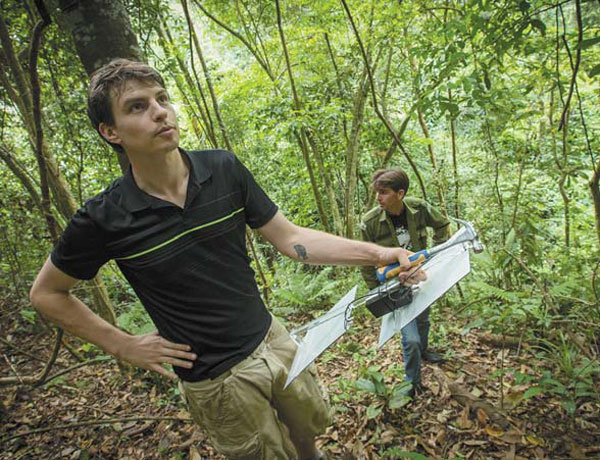The Amazon has eyes
A San Francisco-based nonprofit is converting old smartphones into devices that can detect illegal loggers and call in the authorities
Amid the jungle cacophony of rustling leaves, buzzing bugs and shrieking parrots, another, more menacing sound can be heard: a revving engine and the crush of truck tires that could potentially silence the forest symphony forever.
In a remote patch of the Amazon rainforest, members of an indigenous tribe are hoping that a high-tech device that listens for the trucks, chainsaws and other telltale sounds of encroaching loggers can help save them and their jungle home.
|
Rainforest Connection founder Topher White in Sumatra, Indonesia, during the project's first pilot phase. Rainforest Connection / For China Daily |
Made from discarded smartphones and hidden in the tree canopy, the device is the brainchild of physicist-turned-forest crusader Topher White. His San Francisco-based nonprofit organization, Rainforest Connection, has partnered with the Tembe people of Brazil's Para state on the northern edge of the Amazon, ground zero in the battle for the future of the world's largest rainforest.
"The Tembe believe they're fighting against annihilation, so the stakes are really high," White said at the start of a months-long field test on the Tembe's reserve, where members of the 1,000-strong tribe have clashed in recent months with an armed henchmen of ranchers who are squeezing in on their territory from both sides. "Failure isn't really much of an option, even on the first try."
Despite what White calls the "rough cell network" in the area - the Tembe rely on jerry-rigged antennas to generate even the weakest of signals - the first tests have proven hopeful. Just hours after it was installed, a device successfully picked up the sound of a passing car and generated an alert to White's phone.
Once the system is up and running, with devices installed along the perimeter of the 6,000-square-kilometer reserve, the idea is that alerts will be sent in real time to the roughly 30 tribe members who are the Tembe's designated "rangers", charged with repelling invaders.
The vehicle that triggered the initial alert "wasn't a logging truck, it was just a car passing," said White, "but it's really exciting because it shows that the system works."
White, 33, had the idea for the device while on vacation in Indonesia in 2011. He was volunteering at a sanctuary for gibbons, medium-sized apes that are among the most endangered primates.
To give the gibbon a fighting chance, he knew their shrinking habitat had to be protected from illegal loggers. But how to stop the loggers if the forest itself drowns out the roar of their chainsaws?
"I got to thinking that the best way would be to listen for the sounds of chainsaws, pick them up automatically from the forest and be able to figure out where the chainsaws were coming from," White said. "There was pretty good cell phone service, so I thought I could build a solution."
A vital tool
The device he constructed looks like a daisy, with a weatherproofed cell phone at the center, from which solar panels radiate out, to charge it. Attached to tree trunks some 35 meters above the ground, the smartphone picks up ambient sound within a radius of about 3 km and transmits it to the cloud, where software programmed to recognize the sound of chainsaws sends an alert to park rangers' phones when such noises are detected.
In 2013, White went back to Indonesia, to another gibbon reserve, to test his invention. The device worked so well that within 48 hours of installation it led to the apprehension of would-be loggers.
"Since then, because it's a pretty small reserve, they were able to leverage that (first apprehension) to keep loggers out," he said.
Last year, the group conducted another field test in a vast, Forest Stewardship Council-certified logging concession in Cameroon. Under FSC rules, the logging company that holds the concession for the 7,000-sq-km plot is allowed to fell three trees per hectare in exchange for protecting the forest from loggers and poachers. The reality on the ground, however, falls dismally short of that goal.
"The reality is they have this huge area that they're not able to protect," White said.
While in theory Rainforest Connection's device could prove a vital tool for protecting the plot, the poor Internet and cell phone networks proved major stumbling blocks. They've gone back to the drawing board to try to engineer a better solution, and another field test is scheduled for later this year.
Despite their size - Rainforest Connection is a two-man operation, aided by a cadre of dedicated volunteers - the organization has big ambitions.
"We want to show that this is something that can be used elsewhere," said White. "The best way to do this is by working with the tribes."
(China Daily 06/20/2015 page6)















